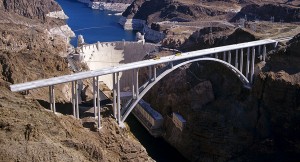 As far back as the 1960’s, federal government agencies identified the US 93 route over the Hoover Dam to be dangerous and inadequate for projected traffic volumes. But it wasn’t until 2001 that Arizona and Nevada officials finally got around to collaborating and executing a plan to construct an alternative river crossing – an amazing bridge over the Colorado River just downstream from the dam.
As far back as the 1960’s, federal government agencies identified the US 93 route over the Hoover Dam to be dangerous and inadequate for projected traffic volumes. But it wasn’t until 2001 that Arizona and Nevada officials finally got around to collaborating and executing a plan to construct an alternative river crossing – an amazing bridge over the Colorado River just downstream from the dam.
If you ever had the chance to drive a truck and trailer across the Hoover Dam before it was permanently closed to commercial traffic after 9-11, you know how right the government officials were back in the 1960’s. But, in true government time, it took over 30 years to start doing something concrete about it! The population of Clark County back in the 1930 census was less than 9,000 people (hard to imagine Las Vegas as a town of only 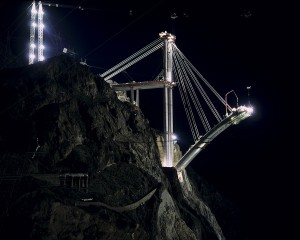 5,000 people). During the second half of the 20th century, development in and around Las Vegas caused the city’s population to balloon to nearly two million. As Las Vegas and the surrounding area became a huge tourist area, it made US 93 over Hoover Dam an important transportation corridor for commercial and passenger traffic between Las Vegas and Phoenix.
5,000 people). During the second half of the 20th century, development in and around Las Vegas caused the city’s population to balloon to nearly two million. As Las Vegas and the surrounding area became a huge tourist area, it made US 93 over Hoover Dam an important transportation corridor for commercial and passenger traffic between Las Vegas and Phoenix.
Oh, but how slowly the wheels of government turn! It was not until 1989 that the U.S. Bureau of Reclamation, which operates the dam, finally began work on the “Colorado River Bridge Project,” which was then put on hold in 1995. After taking over the project in 1997, the Federal Highway Administration released an environmental impact statement in 1998. After that, it still took three years to study the feasibility of several alternative routes and river crossings, as well as the feasibility of modifying the roadway over the dam, restricting traffic over the dam, or doing nothing! How could “doing nothing” even be an option?
The Federal Highway Administration issued a Record of Decision in March 2001. The “Sugarland Mountain Alternative” was the route chosen. This proposal would include 2.2 miles of highway in Nevada, 1.1 miles of highway in Arizona, and a 1900-foot bridge that would cross the river 1,500 feet downstream (south) of Hoover Dam. The design work began in July 2001 just two months before the dam would be closed to commercial traffic forever (after the 9-11 attacks). The Hoover Support Team was in charge of the project design, led by HDR, Inc. and included T.Y. Lin International, Sverdrup Civil, Inc., and other specialist contributors.
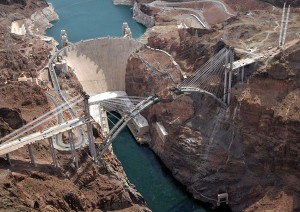 In 2003, work began on the approaches in both states, and then the contract for the arch bridge was awarded in October 2004. Using concrete for the arch and columns with steel construction for the roadway deck, the composite design was selected for schedule and cost control, while also being aesthetically compatible with Hoover Dam. The bridge was built by a consortium of government agencies and contractors, including the Federal Highway Administration, the Arizona DOT, and the Nevada DOT, with RE Monks Construction and Vastco, Inc. building the Arizona Approach, and Edward Kraemer & Sons, Inc. constructing the Nevada Approach. Las Vegas Paving did the roadway surfacing on both approaches. The bridge itself was built by Obayashi Corporation and PSM Construction, USA.
In 2003, work began on the approaches in both states, and then the contract for the arch bridge was awarded in October 2004. Using concrete for the arch and columns with steel construction for the roadway deck, the composite design was selected for schedule and cost control, while also being aesthetically compatible with Hoover Dam. The bridge was built by a consortium of government agencies and contractors, including the Federal Highway Administration, the Arizona DOT, and the Nevada DOT, with RE Monks Construction and Vastco, Inc. building the Arizona Approach, and Edward Kraemer & Sons, Inc. constructing the Nevada Approach. Las Vegas Paving did the roadway surfacing on both approaches. The bridge itself was built by Obayashi Corporation and PSM Construction, USA.
Nevada’s then-Governor Kenny Guinn and Arizona’s then-Governor Janet Napolitano announced the name for the bridge at a ceremony in late 2004. Mike O’Callaghan was a decorated Korean War veteran, Governor of Nevada from 1971-1979, and then the executive editor at the Las Vegas Sun newspaper for many years until his death in March 2004. Pat 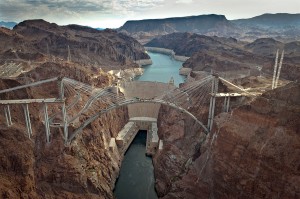 Tillman played football for Arizona University and then for the Arizona Cardinals until he gave up his multi-million dollar career in the National Football League to enlist as in infantryman in the U.S. Army – he was later killed by friendly fire in Afghanistan on April 22, 2004. The Mike O’Callaghan-Pat Tillman Memorial Bridge is the first concrete-and-steel composite arch bridge built in the United States. The roadway is four lanes wide and 900 feet above the Colorado River. The bridge itself is 1,900 feet long and has a 1,060 foot span. It includes the widest concrete arch in the Western Hemisphere. Its height is second only to the Royal Gorge Bridge, which hangs 955 feet above the Arkansas River in Colorado, which was built in 1929 in just five months for the paltry cost of $350,000.
Tillman played football for Arizona University and then for the Arizona Cardinals until he gave up his multi-million dollar career in the National Football League to enlist as in infantryman in the U.S. Army – he was later killed by friendly fire in Afghanistan on April 22, 2004. The Mike O’Callaghan-Pat Tillman Memorial Bridge is the first concrete-and-steel composite arch bridge built in the United States. The roadway is four lanes wide and 900 feet above the Colorado River. The bridge itself is 1,900 feet long and has a 1,060 foot span. It includes the widest concrete arch in the Western Hemisphere. Its height is second only to the Royal Gorge Bridge, which hangs 955 feet above the Arkansas River in Colorado, which was built in 1929 in just five months for the paltry cost of $350,000.
A construction project of this magnitude rarely gets done without problems, and this massive bridge was certainly no exception. A four-month delay started in May 2006 when a permit problem arose between Clark County and the subcontractor, Casino Ready Mix, over the operation of a concrete batch plant. Then, on September 15th of that same year, strong winds across the Black Canyon caused the collapse of the “high-line” crane system that was used to carry workmen and materials at the bridge site. There were no injuries or fatalities because of this accident, but it took two years to clean up the debris and get a new crane installed to finish the job. Work was also halted in November 2008 when 48-year-old Sherman Jones was killed when a jack punctured his chest while he was adjusting a cable used to align temporary concrete towers.
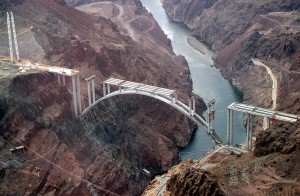 In March 2008, work was completed on the approach spans, which consisted of seven pairs of concrete columns – five on the Nevada side and two on the Arizona side. Constructed from both sides of the bridge concurrently, the arch was supported by diagonal cable stays strung from temporary towers. In May of 2009, the concrete arch was 50% complete. In August of 2009, the twin arch spans were completed with the casting of the center segments. The two sides were only 3/8 of an inch apart when they came together in the middle. The gap was filled with a block of reinforced concrete. After the gap was filled, the temporary cables were removed, leaving the arch self-supporting.
In March 2008, work was completed on the approach spans, which consisted of seven pairs of concrete columns – five on the Nevada side and two on the Arizona side. Constructed from both sides of the bridge concurrently, the arch was supported by diagonal cable stays strung from temporary towers. In May of 2009, the concrete arch was 50% complete. In August of 2009, the twin arch spans were completed with the casting of the center segments. The two sides were only 3/8 of an inch apart when they came together in the middle. The gap was filled with a block of reinforced concrete. After the gap was filled, the temporary cables were removed, leaving the arch self-supporting.
All eight of the vertical piers on the arch had been set and capped by December 2009, and at the end of the month, the first of thirty-six 50-short-ton girders had been set in 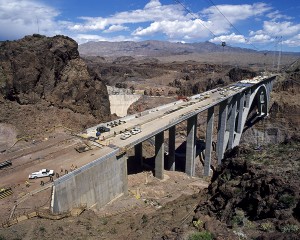 place for the roadway. By mid-April of the following year, all of the girders were set in place – now the construction crews could walk across the structure from Arizona to Nevada. Pouring of the bridge deck began shortly after that, and by July, the entire bridge deck was fully paved. The high-line cranes were then removed from the site, as the overall project neared completion.
place for the roadway. By mid-April of the following year, all of the girders were set in place – now the construction crews could walk across the structure from Arizona to Nevada. Pouring of the bridge deck began shortly after that, and by July, the entire bridge deck was fully paved. The high-line cranes were then removed from the site, as the overall project neared completion.
With the necessity of a bypass long overdue, a dedication ceremony was held on October 14th, 2010 with a grand opening party being held on October 16th. Bicycle and pedestrian traffic was allowed on October 18th, and on October 19, 2010 vehicular traffic was finally allowed to cross the bridge (all of this happened a few weeks earlier than had been originally estimated). The roadway over Hoover Dam was closed to through traffic and all visitor access to the dam was routed to the Nevada side. Following a security inspection, vehicles are still allowed to drive across the dam to the Arizona side, but must return to the Nevada side to return to US 93. The stretch between the present US 93 and the former US 93 route has been re-designated as Nevada Route 172.
 Even though their dedication dates were nearly 75 years apart, both of these man-made wonders (the bridge and the dam) only took five years each to complete. The bridge would have been done in only three years had it not been for the two-year delay because of the crane collapse. I still find it interesting that even with all of our advances over the last 75 years, to build something this monumental still takes time – and LOTS of money (the dam was built for $48 million while the bridge cost $240 million). Now, you have one more reason to visit this amazing area, which includes the excitement of Las Vegas, the beauty of Lake Mead, the awe-inspiring ingenuity of Hoover Dam, and now the engineering marvel of the eye-catching yet functional Mike O’Callaghan-Pat Tillman Memorial Bridge. Do yourself a favor and visit this area when you can, because there is no place like it on earth.
Even though their dedication dates were nearly 75 years apart, both of these man-made wonders (the bridge and the dam) only took five years each to complete. The bridge would have been done in only three years had it not been for the two-year delay because of the crane collapse. I still find it interesting that even with all of our advances over the last 75 years, to build something this monumental still takes time – and LOTS of money (the dam was built for $48 million while the bridge cost $240 million). Now, you have one more reason to visit this amazing area, which includes the excitement of Las Vegas, the beauty of Lake Mead, the awe-inspiring ingenuity of Hoover Dam, and now the engineering marvel of the eye-catching yet functional Mike O’Callaghan-Pat Tillman Memorial Bridge. Do yourself a favor and visit this area when you can, because there is no place like it on earth.
